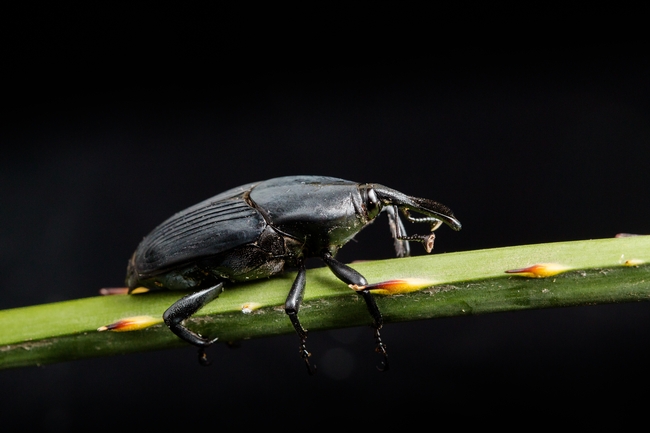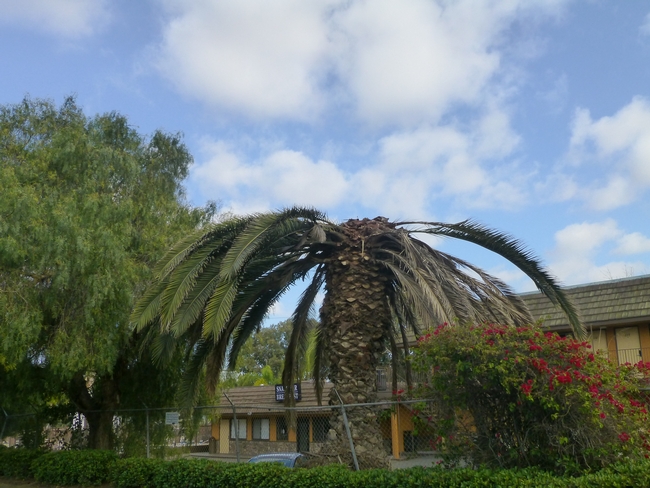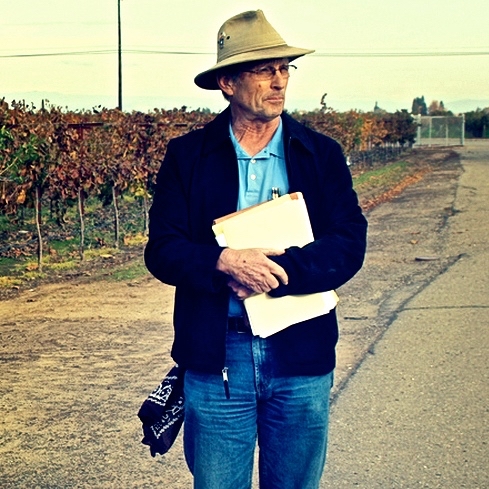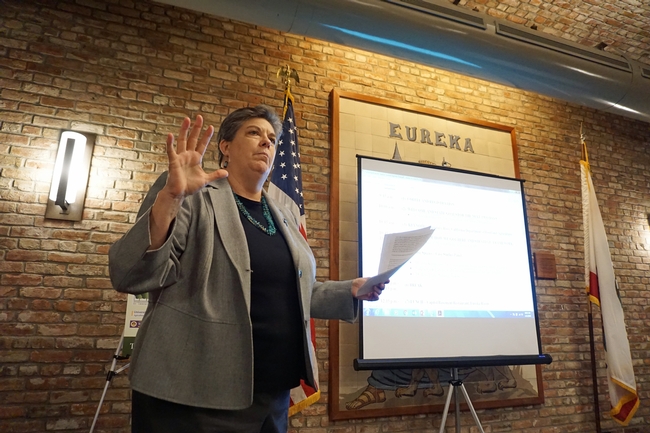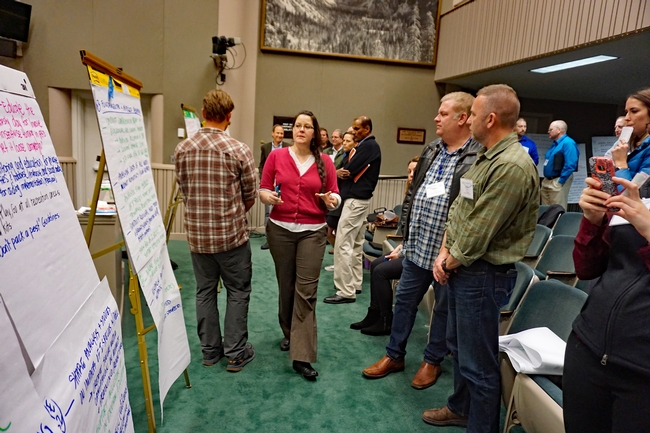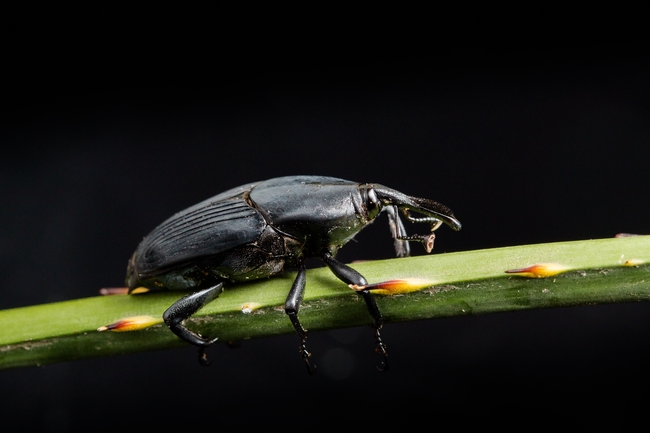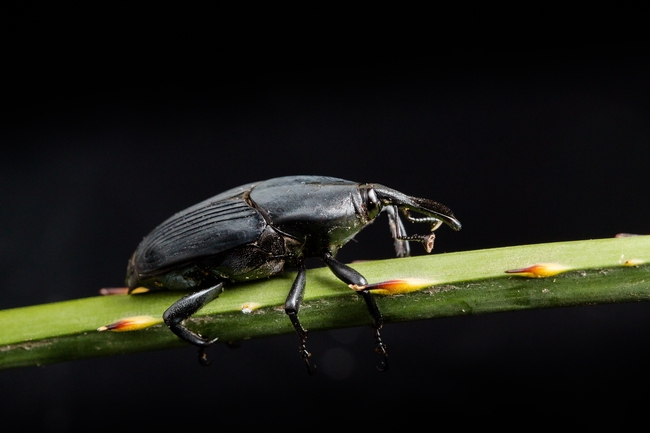Posts Tagged: Mark Hoddle
South America palm weevil is killing palm trees in Southern California
South American palm weevils that have made their way north from Mexico are having a destructive impact on palm trees in the San Diego region, reported Abbie Alford on CBS News 8 TV in San Diego.
UC Cooperative Extension specialist Mark Hoddle, the director of the Center for Invasive Species Research at UC Riverside, toured the reporter through the hard-hit Sweetwater Reserve in Bonita, where 10 percent of the palms die every three months.
“We are going to see hundreds, thousands of Canary Island Date Palms die over the next couple of years,” he said.
The weevils use their protruding noses to drill holes in the palm, where females lay their eggs.
San Diego County Agriculture, Weights and Measurements said it plans to remove 50 infested Canary Island Palms from the Sweetwater Regional Park and is educating arborists about the invasive pest.
A spokesperson for the City of San Diego said it is working with UC Cooperative Extension.
Monthly news round up: January 2018
Woodland as ag hub topic of forum
(Woodland Daily Democrat) Jenice Tupolo, Jan. 30
Developing Woodland as an agricultural center is becoming more of a reality, even as local organizations worked together in creating a forum focused on agricultural innovation in Yolo County.
...The city of Woodland, AgStart, UC Agricultural and Natural Resources, and the city's Food Front initiative hosted keynote speaker and vice president of the UC ANR, Glenda Humiston, at the conference.
http://www.dailydemocrat.com/business/20180130/woodland-as-ag-hub-topic-of-forum
Small Farmers in Fresno Hope for Big Moringa Payoff
(KQED) Katrina Schwartz, Jan. 26
The Mouas, along with other Hmong farmers growing moringa, have been working with farm advisers at Fresno County's UC Cooperative Extension to learn how to dry, powder and store their moringa so they can expand into new markets. Most farmers sell it fresh, but most of the health food craze exists around moringa powder, often imported from India.
… “Value-added products are a great way for a small family farm to increase their income,” said Ruth Dahlquist-Willard, a small-farm adviser with the program. Many farmers are accustomed to only selling fresh produce. They plant a diverse set of crops in a small area and sell a little bit of everything. Producing a product that requires the extra step of drying, grinding and storing is a whole new world for many of them.
“I think there's a lot of opportunity there,” Dahlquist-Willard said. She's particularly excited about how a product might bring the younger generation back to their family farms. Kids who have gone off to college for business, marketing or graphic design might see a new kind of future for themselves on the family farm with a product like moringa.
https://ww2.kqed.org/news/2018/01/26/small-farmers-in-fresno-hope-for-big-moringa-payoff/
SLO County's Top 20 Under 40: Meet the 2017 award winners
(San Luis Obispo Tribune) Staff, Jan. 26
…Katherine E. Soule, 35, is director of the UC Cooperative Extension for SLO and Santa Barbara counties, where she's earned state and national recognition for improving community health and increasing diversity in youth participation.
As the extension's youth, families and communities advisor for the last several years, Soule developed new 4-H programs engaging underserved youths and promoting healthy living, leadership and social development. Her efforts nearly doubled enrollment and boosted Latino participation 26.8 percent. She's delivered nutrition education to more than 10,000 people through various partnerships.
http://www.sanluisobispo.com/news/business/article196536784.html
Flooding alfalfa for groundwater recharge
(Morning Ag Clips) Jan. 24
A rigorous field study in two California climate zones has found that alfalfa can tolerate very heavy winter flooding for groundwater recharge. The research was published online Jan. 16 in California Agriculture journal.
The alfalfa research is the latest in a series of projects studying the effects of using land planted with permanent crops – including almond orchards and vineyards – to capture and bank winter storm water. Such projects have great promise but also require collaboration across multiple jurisdictions and agencies. UC Agriculture and Natural Resources vice president Glenda Humiston has made groundwater recharge on working lands and open spaces a division priority and is working with water and land use leaders around the state to facilitate it through policy recommendations and cross-agency collaboration.
https://www.morningagclips.com/flooding-alfalfa-for-groundwater-recharge/
Band Canker Affecting Younger Almonds
(California Ag Today) Patrick Cavanaugh, Jan. 24
Brent Holtz is a UC cooperative extension Pomology Farm Advisor for San Joaquin County. He recently told California Ag Today about how the fungus band canker on almonds is becoming more prevalent in the San Joaquin Valley.
“I've seen a lot more band canker, which is caused by a pathogenic fungus, Botryosphaeria dothidea, and we're seeing it on young orchards, especially in in San Joaquin county," said Holtz. "We've seen that a lot out in the delta and we've seen it in eastern San Joaquin county where the soils tend to be a little heavier, maybe old dairy ground and richer and we don't really know why."
https://californiaagtoday.com/band-canker-affecting-younger-almonds/
CCOF Annual Conference to Focus on Organic Hotspots
AgNet West) Jan. 22
Registration is available for the California Certified Organic Farmers (CCOF) annual conference, Organic Hotspots: Revitalizing Rural America. The event is scheduled for February 22 and 23 at the Sheraton Grand Sacramento Hotel in Sacramento.…
The event will focus on organic hotspots and how rural economies can potentially be stimulated by organic production. Topics will include partnerships between elected officials and the organic community, the role of education and research, along with the process of growing organic produce in local communities. The event will conclude with a keynote speech from Glenda Humiston, Vice President of the University of California Division of Agriculture and Natural Resources.
http://agnetwest.com/ccof-annual-conference-organic-hotspots/
California Today: 100 Million Dead Trees Prompt Fears of Giant Wildfires
(New York Times) Thomas Fuller, Jan. 19
The more than 100 million trees that died in California after being weakened by drought and insect infestations have transformed large swaths of the Sierra Nevada into browned-out tree cemeteries. In some areas more than 90 percent of trees are dead.
This week a group of scientists warned in the journal BioScience that the dead trees could produce wildfires on a scale and of an intensity that California has never seen.
…“It's something that is going to be much more severe,” said Scott Stephens, a professor of fire science at Berkeley and the lead author of the study. “You could have higher amounts of embers coming into home areas, starting more fires.”
Winter's good time for gopher control in nut crops
(Western Farm Press) Cecelia Parsons, Jan. 17, 2018
Tree nut growers who are plagued by gopher invasions in their orchards need to stick with effective control measures if they want to minimize tree losses.
Pocket gophers are common in most nut production areas, says Joe Connell, University of California Cooperative Extension Farm Advisor Emeritus in Butte County. In the absence of cover crops or weeds, they will gnaw on tree roots and trunks, and the hungry vertebrate pests can even girdle — and kill — older trees. Trees with root damage and girdling will lose production, and will be susceptible to crown gall, which weakens their structural strength.
http://www.westernfarmpress.com/tree-nuts/winter-s-good-time-gopher-control-nut-crops
Bloomington nursery's citrus trees to be destroyed by California agriculture department
(ABC7 KABC) Rob McMillan, Jan. 17, 2018
Roxana Vallejo was 12 years old when her parents opened up Santa Ana Nursery in Bloomington. Wednesday, the California Department of Food and Agriculture will be at her business to destroy almost all of their citrus trees. Vallejo said the combined value of the trees is almost $1 million.
"They're all fine, and look at all the new growth, it's pretty good," Vallejo said.
The reason they're being cut down is huanglongbing, or HLB, one of the world's worst citrus diseases. The insect that spreads HLB has taken a strong foothold in Southern California.
"It's estimated that the citrus industry may go commercially extinct unless they can get a handle on this problem," said Mark Hoddle, UC Cooperative Extension specialist at UC Riverside, more than one year ago.
http://abc7.com/food/ie-nurserys-citrus-trees-to-be-destroyed-by-ca-agriculture-department/2959173/
OPINION: Ranchers give thanks
(Ventura County Star) Beverly Bigger, president of the Ventura County Cattlemen's Association, Jan. 16, 2018
The majority of attention and sympathy have rightly gone toward those who lost their homes in the Thomas Fire, but I would like to take a moment to highlight the story of others who have suffered as well. They are largely invisible, hidden among the hills and canyons, but their contribution to the county is significant.
Ventura County is home to a robust and historic cattle industry, one that makes up a $2 million portion of Ventura County's agricultural sector. Ranchers play an important role in land management as well, their grazing operations clearing overgrown brush, reducing the fuel available to wildfires and protecting nearby communities.
In the space of 12 hours, the Thomas Fire ripped through vital grazing land that cattle rely on for their daily feed. Sadly, some animals were also lost to the fire.
With feed and fencing gone, many ranchers had hard decisions to make regarding the future of their operations, and some were not prepared for this kind of disaster. Thankfully, we have dedicated public servants who stepped up to help the cattle industry.
Ventura County Agricultural Commissioner Henry Gonzales, Matthew Shapero from the UC Cooperative Extension, and Donna Gillesby and Bryan Bray of Ventura County Animal Services all reached out to ask what they could do to help.
An emergency program was put in place to supply five days of hay until ranchers could get on their feet. The UC Extension also provided a one-stop location where ranchers could meet with representatives from multiple agencies to apply for assistance programs.
The assistance of these agencies was very much appreciated. We want to thank and recognize them for helping us in our time of need. We look forward to returning to our passion: managing and improving the land and continuing Ventura County's ranching heritage.
http://www.vcstar.com/story/opinion/readers/2018/01/16/ranchers-give-thanks/1038625001/
Farm advisor tests strategies for controlling horseweed
(Ag Alert) Bob Johnson, Jan. 10, 2018
One morning last summer, University of California Cooperative Extension vineyard weed control advisor John Roncoroni displayed a horseweed plant that had grown to more than 10 feet tall in a Yolo County vineyard.
Horseweed, which is widely seen on the sides of the state's highways, is among the glyphosate-resistant weed pests that can develop healthy populations in even well managed vineyards.
"We're really having problems with weeds coming in the fall that are resistant to Roundup," Roncoroni said. "Willow herb is tolerant; it's never been completely controlled by glyphosate."
http://www.agalert.com/story/?id=11460
Pomegranate returns not so wonderful but largest grower says otherwise
(Hanford Sentinel) By John Lindt, Jan. 11, 2018
A few years ago Central Valley pomegranate growers appeared to be riding a rising tide of popularity for pomegranates spurring optimism about the crop's future. Growers, including those in Kings County, enjoyed prices of over $1,700 a ton as recently as 2011.
After a significant planting of new trees, by 2015 pomegranate tonnage was fetching just $450 a ton in Fresno County and falling to $362 a ton in Tulare County according to its 2016 crop report.
…UC Farm Adviser Kevin Day says it's simple economics. “We are seeing both overproduction and lack of demand for pomegranates despite expectations to the contrary."
Western Innovator: Promoting sustainable ranching
(Western Farm Press) Tim Hearden, Jan. 9, 2018
Tracy Schohr has devoted much of her career to promoting sustainability in ranching.
While at the California Cattlemen's Association, she put on an annual “rangeland summit” that brought ranchers together with environmental experts and climate change policymakers.
She also worked on a program to limit ranchers' risk of facing Endangered Species Act violations if they created habitat on their land.
After going back to school to earn her master's degree at the University of California-Davis, Schohr has become a UC Cooperative Extension livestock and natural resources adviser based in Plumas, Sierra and Butte counties. http://www.capitalpress.com/California/20180108/western-innovator-promoting-sustainable-ranching
Weed Control with Brad Hanson UC Cooperative Extension Weed Specialist at UC Davis
(California Ag Today) Patrick Cavanaugh, Jan. 8, 2018
“Weeds are probably one of the year-in, year-out problems that growers face,” said Brad Hanson, UC Cooperative Extension, who discussed herbicide resistance with California Ag Today.
Building blocks for tending flocks
(Auburn Journal) Julie Miller, Jan. 7, 2018
Counting sheep is no longer for the tired and sleepy.
Shepherding has become a booming industry in Placer County. At last count, there are 9,000 head of sheep registered with the county, said Dan Macon, livestock and natural resources advisor for University of California, for Placer and Nevada counties. And there may be more sheep that have not been registered, perhaps because they are in a smaller flock of 10 to 15, he said.
Sheep have proven to be versatile. Not only raised for the meat and milk, but also wool fibers, plus, they can help reduce fire danger by eating away tall grasses and shrubs.
http://www.auburnjournal.com/article/1/06/18/building-blocks-tending-flocks#
After a recent outbreak of E.coli, is it safe to eat romaine lettuce? Experts differ
(Fresno Bee) Robert Rodriguez, Jan. 5, 2018
If you are staying away from romaine lettuce because of an outbreak of E.coli, it's understandable. But at least one food safety expert says it may not be necessary.
…But University of California food safety expert Trevor Suslow said it's unlikely the lettuce you buy at the grocery store these days is going to do you any harm. That's because the illnesses happened from Nov. 15 through Dec. 8. Lettuce sold during that period wouldn't be around anymore.
“It's not going to last that long, it's gone,” Suslow said.
http://www.fresnobee.com/living/food-drink/article193301924.html
Cattle Ranchers Join Conservationists To Save Endangered Species And Rangelands
(Forbes) Diana Hembree, Jan. 5, 2018
…California has a strong incentive to preserve its 18 million acres of ranchland: Cattle and calves are the state's fourth-leading agricultural commodities (milk and cream are No. 1), according to state agricultural data. But in a Duke University survey of the state's ranchers, more than half said they were “more uncertain than ever” that they would be able to continue ranching. California is losing an estimated 20,000 acres of rangeland each year, according to the Nature Conservancy, and on any given day ads for the sale of cattle ranches dot the Internet. The median age of California ranchers is 58 to 62, and more are aging out of the business with no children interested in taking over the ranch.
But this trend can be reversed, according to Lynn Huntsinger a professor of environmental science and rangeland ecology at UC Berkeley. To preserve these landscapes for future generations, ranchers need payment and recognition for their ecosystem services “in order to preserve these working landscapes for future generations,” Huntsinger writes.
Months after Wine Country fires, damaged vineyards face uncertainty
(SF Chronicle) Esther Mobley, Jan. 4
…“No one knows what's the real threshold for heat damage,” says Rhonda Smith, the Sonoma County-based viticulture farm adviser for the University of California, who has come to Gilfillan to consult on its rehabilitation.
Much of the conventional wisdom about how fires interact with vines — that vines can't burn, because of their high water content, for instance — didn't turn out to be true for every vineyard, she says.
“In 99 percent of cases, vines were fire breaks,” says Smith. But if there was dry vegetation, if there was wood mulch on the ground, if the soil was especially dry — if, if, if — then they weren't.
http://www.sfchronicle.com/wine/article/Months-after-Wine-Country-fires-damaged-12474309.php
Progress reported on robotic weeders for vegetables
(Ag Alert) Bob Johnson, Jan. 4
The next generation of computer-controlled, automated cultivators will be able to use cameras to remove weeds in the seed line as close as 1 inch from young tomato or lettuce plants, without damaging the crop.
…
“It must be more than half the lettuce acreage that is already using the automated thinners,” said Steve Fennimore, UC Cooperative Extension vegetable weed specialist.
Fennimore is supervising the Salinas lettuce trials of “marking” the crop in order to make this technology practical for weeding as well.
“The weeders already out there tend to be prototypes that people are still experimenting with,” he said.
http://www.dailydemocrat.com/article/NI/20180104/NEWS/180109957
2017's natural disasters cost American agriculture over $5 billion
(New Food Economy) Sam Bloch, Jan. 4, 2018
Over a period of 10 months in 2017, America experienced 16 separate, billion-dollar weather and climate-related disasters. Those weather events carved paths of destruction straight through some of the most fertile and productive regions of the country, wreaking havoc on beef cattle ranches in Texas, soaking cotton and rice farms in Louisiana, orange groves in Florida, and burning up vineyards in California. And that was all before Southern California's still-active Thomas fire, which began on December 4, and then closed in on the country's primary avocado farms. It's now the state's largest-ever, in terms of total acreage.
- Acres of cherimoya trees in Santa Barbara County destroyed by the Thomas fire: 100
- Total dollar value of Santa Barbara cherimoya fruit damaged by fire: $5,000,000
- Acres of avocado fields in Santa Barbara and Ventura Counties threatened by wildfire: 5,260
- Estimated pounds of Hass avocados in Ventura County lost to wildfire: 8,060,000
- Total dollar value of that lost harvest: $10,175,750
- Approximate percentage of American avocado crop threatened by wildfire: 8
- Expected effect of wildfire on avocado prices in America, due to reliance on imports: 0
- Winegrape acreage in Napa and Sonoma Counties: 104,847
- As a percentage of total California winegrape acreage: 22
- Estimated dollar value of unharvested Cabernet grapes in those counties, before the wildfires: $175,000,000
- Estimated dollar value of those grapes, now tainted by smoke: $29,000,000
- Bottles of 2016 Napa Cabernet you can buy for the price of two 2017 vintages, due to winegrape scarcity: 3
California wildfire data from Daniel A. Sumner, Ph.D. of UC Agricultural Issues Center, USDA NASS, Ben Faber, Ph.D. of UC Cooperative Extension Ventura.
https://newfoodeconomy.org/2017-natural-disasters-agriculture-damage-5-billion/
There Is No “No-Fire” Option in California
(Bay Nature) Zach St. George, Jan. 2, 2018
As the use of prescribed fire by Cal Fire declined in recent decades, its use also declined with private landholders, says Lenya Quinn-Davidson, director of the Northern California Prescribed Fire Council, who leads prescribed burning workshops across the state. Scott Stephens, the UC Berkeley professor, concurs. Decades of suppression left the western U.S. with relatively few people trained to carry out the work: “We just don't have that experience to pass on.” But it's important not to let the current enthusiasm pass, he says—as climate change continues to push conditions toward extremes, as wildfires consume more and more of fire agency budgets, and as the wildland-urban interface expands, it will only become more difficult to bring fire back.
https://baynature.org/article/no-no-fire-option-california/
Scientist discusses working on Food Evolution movie
(Brownfield Ag News) Larry Lee, Jan. 1
A scientist involved in a movie about genetically modified food says many don't understand what GM is, let alone the benefits. Alison VanEenennaam says, “Really, it's a breeding method, and I think the public sector applications for things like disease resistance have very compelling societal benefits that I think most people can relate to. I don't think we want plants and animals getting sick, and if we can solve that problem genetically rather than using chemicals, I think people get that.”
VanEenennaam is a geneticist at the University of California. She tells Brownfield there is a lot of unnecessary fear about eating genetically modified food. “The safety around GM (Genetically Modified) has been established and is, you know, agreed on by every major scientific society in the world and yet we've got the vast majority of consumers that don't believe that.”
https://brownfieldagnews.com/news/scientist-discusses-working-food-evolution-movie/
Urban Edge farm program offers immersion-style learning
(East Bay Times) Lou Fancher, Jan. 1, 2018
After operating a pilot version of the ambitious program, a $200,000 grant from the USDA National Institute of Food and Agriculture's Beginning Farmer and Rancher Development Program is a launch pad for the immersive learning experience.
For the first cohort of students, many of them women and/or people of color, immigrants, refugees, veterans or farmers-to-be with limited resources, the land is a classroom. Instruction comes from First Generation and experts from the National Center for Appropriate Technology and UC Cooperative Extension. Participation in the program represents opportunity and fulfills dreams the first-time farmers hold of agricultural avocation, economic stability, families, homesteads and permanence.
https://www.eastbaytimes.com/2018/01/01/urban-edge-farm-program-offers-immersion-style-learning/
Tribute to Paul Verdegaal – one of Lodi's “men behind the curtain”
(Lodi Wine blog) Randy Caparoso, Jan. 1, 2018
This coming February 6, 2018, Lodi winegrowers will get together for their 66th Annual LODI GRAPE DAY. They will also mark the occasion with a celebration of the retirement of Paul Verdegaal, who has been working full-time as San Joaquin County's viticulture, bush berry and almond Farm Advisor under the auspices of UCCE (University of California Cooperative Extension) since 1986.
http://www.lodiwine.com/blog/Tribute-to-Paul-Verdegaal---one-of-Lodi-s--men-behind-the-curtain-
Ag leaders, scientists set priorities to prevent invasive pest threats to the environment and economy
The gypsy moth, an interloper from Europe and Asia, is threatening California's majestic oaks in Ventura County.
Invasive desert knapweed, which comes from Africa, has made its first North American appearance in in California's Anza-Borrego Desert, where it has started to crowd out native plants.
Asian citrus psyllids are slowly spreading the devastating huanglongbing disease in Southern California citrus.
River rats from South America, called nutrias, are munching voraciously on wetland plants in some areas of Stanislaus, Merced and Fresno counties.
These are just a few of the insects, weeds, animals and diseases that have entered the state of California from elsewhere on the globe, causing tremendous ecological damage and huge economic losses to agricultural crops, which ultimately affect every resident of California.
Based on historical data, a new invertebrate species establishes itself in California about every six weeks, on average. They don't all become serious pest problems, but many evade eradication efforts, disrupt carefully balanced integrated pest management programs, hijack sensitive ecosystems, and spoil valued recreational resources and urban landscapes.
A diverse group of university scientists, federal and state government representatives, county agricultural commissioners and non-profit organization leaders who are battling these pests converged at a summit in the state capitol Jan. 11 and 12 to coordinate their efforts, pool intellectual resources, and plot a strategy for protecting agricultural crops, natural resources, unique ecological communities, cityscapes and residential neighborhoods.
“We are a big, beautiful, special place, blessed with great weather and diverse geography,” said California Department of Food and Agriculture Secretary Karen Ross at the summit. “That means a lot to our many visitors – including pests.”
Glenda Humiston, vice president of UC Agriculture and Natural Resources, which co-sponsored the summit, outlined the goals.
“We know that collectively, we have the tools and expertise to prevent invasive species from entering California, spreading and becoming established,” Humiston said. “I am so pleased with the numbers of people here today, and the expertise that you bring.”
A fundamental component of the fight against damaging invasive species is research, Humiston said, adding that the European grapevine moth in an apt example. The pest was detected in California's wine country in 2009, and later found as far south as Fresno County. A multi-agency collaboration responded quickly.
UC ANR academics studied the moth's biology, life cycle, host range and proven management practices. They developed a pest management program that relied on mating disruption with pheromones and application of carefully timed insecticides. In short order, the moth population plummeted, and the state was declared free of European grapevine moth, lifting a quarantine, enhancing farmers' ability to export its product, and preserving the communities' economic wellbeing.
“This multi-agency collaboration contributed to a successful, science-based response plan to a serious pest threat,” Humiston said.
She noted, however, that prevention is the best option.
“This is critical,” Humiston said. “Once the pests are here, they cost us millions upon millions of dollars to manage, not to mention the devastation and destruction inflicted on our crops, natural resources and the damage to local economies.”
In 2010, CDFA created a strategic framework for addressing California's ongoing invasive pest problems and potential future introductions. Successful implementation of the framework requires partnerships involving government from the state to local levels, the agriculture industry and commodity groups, non-governmental organizations committed to the environment, and researchers at UC and other universities.
UC Cooperative Extension advisor emeritus John Kabashima was instrumental in bringing the summit to fruition. Kabashima, who retired in 2015, continues to lead a battle against invasive shot hole borer pests in Southern California. The insects, originally from Asia, are killing thousands of Southern California trees, and have the potential to kill millions of trees in urban areas, natural areas and even on farms in parts of the state as far north as Sacramento.
“We convened this meeting to bring together experts in the field and people who are feeling the impacts,” Kabashima said. “We're trying to start a 21st century invasive pest program that would then be implemented and funded to address the urgent issues before they cause any more devastation.”
At the end of the two-day summit, the participants voted to decide the most pressing issues and best strategies to take forward to their agencies, coalitions, research groups, legislators and constituents. Key strategies that emerged were:
- Analyze the economic impacts of invasive species management and the cost of “doing nothing.”
- Develop and maintain statewide surveys and map high-risk surveys.
- Increase funding to study invasive species' biology.
- Create a standing rapid response workgroup to guide response to new invasive species. Fund a rapid response emergency fund.
- Enact regulations to control high-risk vectors, such as soil, green waste, gravel, forage, straw and firewood.
- Formalize the Invasive Species Council of California (ISCC) and the California Invasive Species Advisory Committee (CISAC).
Mark Hoddle, UC Cooperative Extension biological control specialist and director of the Center for Invasive Species Research at UC Riverside, said the summit was a valuable part of the ongoing battle against invasive pests.
“It's good to see the number of agencies and organizations involved with invasive species issues,” Hoddle said. “I'm impressed with the energy in coming up with these priority lists.”
Summit outcomes will include sending recommended action items to the Legislature for funding consideration.
“Without financial support, many of the management tools that prevent unwanted incursions, find and monitor incipient pest populations, and develop sustainable, cost-effective management programs won't be possible,” Hoddle said.
View Glenda Humiston's opening remarks here:
South American palm weevil stars in a Hollywood horror film
One of Los Angeles' quintessential icons - palm trees - are being threatened by an invasive pest from overseas - the South American palm weevil. KQED Science produced a clever overview on the life and times of this devastating pest, punctuating it with a surprise ending that features UC Cooperative Extension specialist Mark Hoddle.
The story outlines the pest's life cycle, which starts when a female lays its eggs in the crown of a palm. They hatch and larvae eat the plant from the inside out, eventually killing the palm. The larvae pupate, complete metamorphosis, then fly off to find another palm to attack.
Hoddle conducted an experiment to determine how far the weevils can fly. He glued the pest on a sort of insect treadmill and let it fly in circles. He found that they can travel up to 15 miles a day, enough to easily hopscotch from palm to palm on their own and spread widely.
The biocontrol scientist demonstrates one way to get rid of South American palm weevils. If you're not squeamish you can view the video on the KQED website.
South American palm weevils are destroying SoCal palms
Communities in Southern California are watching their valued landscape palm trees suffer mortal damage from an invasive pest that is making its way northward from Mexico, reported Marty Graham in San Diego Reader. The South American palm weevil lays eggs in the palm tree's crown, where its grubs destroy tissue that holds the fronds.
"The first sign of infestation is seeing the crown droop and turn brown," said Mark Hoddle, UC Cooperative Extension biological control specialist at UC Riverside. In time, the crown can fall off.
"The crowns weigh a couple of hundred pounds and, if they fall on something like a car or house, they can do considerable damage," Hoddle said.
For now, the pest appears to be focusing on Canary Island palms, but have been known to lay eggs in other ornamental palms and date palms.
"I hate to think of what could happen if they reach the palm oases in the Anza-Borrego Desert," Hoddle said of the treasured California native palms that grow in Southern California desert canyons.
South American palm weevil is a relatively large pest capable of flying substantial distances.
"We've tested their flying capacity and our data suggests it can fly quite far," Hoddle said. "It's potential territory in California and the Southwest is enormous."
The only control measure at the moment is repeated treatment with pesticides.
"There are palm trees in the Mediterranean with PVC pipes up the side and a shower head at the top where a pump blasts pesticides every few months," he said. "There are also systemic pesticides you can put in the tree roots."
For more information or to report a possible South American palm weevil infestation, see the Center for Invasive Species Research website.


